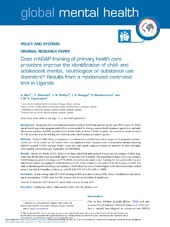| dc.contributor.author | Akol, Angela | en_US |
| dc.contributor.author | Makumbi, Fredrick Edward | en_US |
| dc.contributor.author | Babirye, Juliet N. | en_US |
| dc.contributor.author | Nalugya, Joyce | en_US |
| dc.contributor.author | Nshemereirwe, Sylvia | en_US |
| dc.contributor.author | Engebretsen, Ingunn Marie S. | en_US |
| dc.date.accessioned | 2019-01-10T12:50:08Z | |
| dc.date.available | 2019-01-10T12:50:08Z | |
| dc.date.issued | 2018 | |
| dc.identifier.issn | 2054-4251 | |
| dc.identifier.uri | https://hdl.handle.net/1956/18871 | |
| dc.description.abstract | Background. Integrating child and adolescent mental health (CAMH) into primary health care (PHC) using the WHO mental health gap action program (mhGAP) is recommended for closing a mental health treatment gap in low- and middle- income countries, but PHC providers have limited ability to detect CAMH disorders.We aimed to evaluate the effect of PHC provider mhGAP training on CAMH disorder identification in Eastern Uganda. Methods. Thirty-six PHC clinics participated in a randomized controlled trial which compared the proportion of intervention (n = 18) to control (n = 18) clinics with a non-epilepsy CAMH diagnosis over 3 consecutive months following mhGAP-oriented CAMH training. Fisher’s exact test and logistic regression based on intention to treat principles were applied. (clinicaltrials.gov registration NCT02552056). Results. Nearly two thirds (63.8%, 23/36) of all clinics identified and recorded at least one non-epilepsy CAMH diagnosis from 40 692 clinic visits of patients aged 1–18 recorded over 4 months. The proportion of clinics with a non-epilepsy CAMH diagnosis prior to training was 27.7% (10/36, similar between study arms). Training did not significantly improve intervention clinics’ non-epilepsy CAMH diagnosis (13/18, 72.2%) relative to the control (7/18, 38.9%) arm, p = 0.092. The odds of identifying and recording a non-epilepsy CAMH diagnosis were 2.5 times higher in the intervention than control arms at the end of 3 months of follow-up [adj.OR 2.48; 95% CI (1.31–4.68); p = 0.005]. Conclusion. In this setting, mhGAP CAMH training of PHC providers increases PHC clinics’ identification and reporting of non-epilepsy CAMH cases but this increase did not reach statistical significance. | en_US |
| dc.language.iso | eng | eng |
| dc.publisher | Cambridge University Press | eng |
| dc.relation.ispartof | <a href=" http://hdl.handle.net/1956/18872" target="blank"> Access to Child and Adolescent Mental Health services in Uganda: Investigating the role of Primary Health Care and Traditional Healers</a> | |
| dc.rights | Attribution CC BY | eng |
| dc.rights.uri | http://creativecommons.org/licenses/by/4.0/ | eng |
| dc.subject | Uganda | eng |
| dc.subject | Child and adolescent | eng |
| dc.subject | Mental health | eng |
| dc.subject | mhGAP | eng |
| dc.subject | Primary care | eng |
| dc.title | Does mhGAP training of primary health care providers improve the identification of child- and adolescent mental, neurological or substance use disorders? Results from a randomized controlled trial in Uganda | en_US |
| dc.type | Peer reviewed | |
| dc.type | Journal article | |
| dc.description.version | publishedVersion | en_US |
| dc.rights.holder | Copyright 2018 The Authors | |
| dc.source.articlenumber | e29 | |
| dc.identifier.doi | https://doi.org/10.1017/gmh.2018.18 | |
| dc.source.journal | Global Mental Health | |
| dc.source.40 | 5 | |

